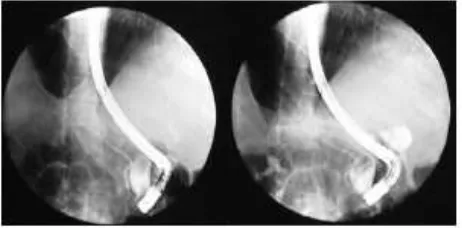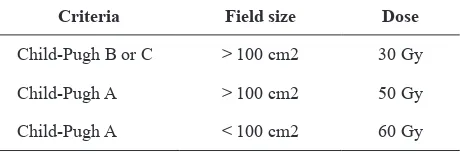255
Vol 17, No 4, October - December 2008 Radiotherapy for icteric type HCC
Pre operative radiation for icteric type hepatocellular carcinoma
A case report
Adianto Nugroho1, Toar J.M. Lalisang2, Soehartati Gondhowiarjo3
Abstrak
Karsinoma Hepatoseluer (KHS) masih menjadi masalah kesehatan di dunia, selain karena insidensnya yang tinggi terkait dengan angka infeksi HBV dan HCV, penatalaksanaanya sangat tergantung pada kondisi penderita dan ekstensi tumor. Pembedahan, berupa reseksi hati maupun transplantasi hati adalah pilihan utama untuk mencapai survival yang baik. Namun demikian, reseksi hati mensyaratkan kondisi hati yang sehat dan ukuran tumor yang kecil sedangkan transplantasi hati belum dikerjakan di Indonesia. Kedua hal ini mendorong pemanfaatan modalitas lain dalam penatalaksanaan KHS, antara lain Ablasi tumor per kutan, Trans Arterial Chemo Embolization (TACE), Kemoterapi dan Radioterapi. Radiasi selama ini ditakuti karena efek samping hepatitis radiasi-nya, akan tetapi dengan berkembangnya teknik radiasi konformal, efek samping tersebut dapat diminimalkan. Makalah ini memaparkan satu kasus KHS tipe ikterik yang mendapat radiasi eksterna di Rumah Sakit Dr. Cipto Mangunkusumo (RSCM) dengan hasil yang memuaskan berupa hilangnya gejala dan penurunan kadar bilirubin. Penderita direncanakan untuk menjalani reseksi hati. (Med J Indones 2008; 17: 255-8)
Abstract
Hepatocellular Carcinoma (HCC) is still a leading health problem worldwide, due to its correlation with HBV and HCV infection and its management which is strongly dependent on patient’s condition and tumor extension. Surgery, with liver resection or liver transplantation offer a good survival rate as a primary management of such cancer. But since liver resection must consider some aspect of liver function and tumor size, and liver transplantation was not a choice in Indonesia, many treatment modalities has been developed which can be used to overcome this problem, such as tumor ablation, transarterial chemo embolization (TACE), chemotherapy and radiotherapy. With the development of conformal radiotherapy, the hepatitis induced radiation therapy could be minimized. This paper present a case of conformal radiation therapy utilization in icteric type HCC in Dr. Cipto Mangunkusumo Hospital, Jakarta. Hepatic resection was planned for this patient. (Med J Indones 2008; 17: 255-8)
Keywords:Hepatocellular Carcinoma, icteric type, radiation therapy, conformal radiotherapy
Radiotherapy is among one of the modalities in the treatment of hepatocellular carcinoma. Its primary usage was for palliative treatment in unresectable cases, but it can also be used as a neodajuvant treatment before liver resection. Previously , there was no documented report on the use of radiotherapy in hepatocellular
carcinoma at RS Dr. Ciptomangunkusumo. We report a case of preoperative radiotherapy for icteric type hepatocellular carcinoma in our hospital in which the result was satisfactory for further liver resection.
CASE ILLUSTRATION
Male, 66 years old, with dyspepsia and jaundice but no history of previous liver diseases. He had icteric eye and skin, hepatomegaly and no sign of mass in the abdomen. The total and direct bilirubin level at admission was 15.8 mg/dl and 11.6 mg/dl respectively. The Albumin level was 3,3 g/dl, with AFP 8 ng/ml and normal Prothrombin time (14; control 13,8) with Child-Pugh B classiication.
1 Digestive Surgery Division, Department of Surgery, Faculty
of Medicine University of Indonesia/Dr. Cipto Mangunkusumo Hospital, Jakarta, Indonesia
2 Department of Surgery, Faculty of Medicine University of
Indonesia/Dr. Cipto Mangunkusumo Hospital, Jakarta, Indonesia
3 Department of Radiotherapy, Faculty of Medicine University of
256 Nugroho et al Med J Indones
CT scan uncovered a low density mass at segment 8 of the liver measuring 81 x 119 mm that compressed the biliary radix and hepatic artery with no associated ascites nor lymph node enlargement (Fig 1A). No metastasis sign was found in the plain thorax photo. And the cytology of the liver biopsy conirmed the diagnosis of Hepatocellular Carcinoma.
Figure 1. CT scan Pre Radiation (A) and Post Radiation (B)
The result of Trans Arterial Chemotherapy with Lipiodol and Adryamicin was unsatisfactory. We found compression of biliary radix due to liver mass at segment 4,5 and 8, with mild dilatation of the intrahepatic biliary ducts on MRCP. Furthermore, ERCP conirmed the existence of Common Bile Duct obstruction (Fig 2).
This patient undergone Three Dimensional Conformal Radiotherapy (3D-CRT) using Linear Accelerator with the total dose of 30 Gy (2 Gy/fraction). After Radiotherapy, CT scan showed hyperdens mass at the right lobe of the liver, measuring 103 x 147 mm with no dilatation of biliary system (Fig 1B)
Figure 2. ERCP pre radiation
The general condition after radiotherapy was good, with marked decreased of jaundice and dyspepsia. The total bilirubin level and albumin was 7.85 mg/dl and 3 g/dl respectively (Fig 3). On follow up, there were no major complains and this patients was planned to undergo liver resection.
Figure 3. Bilirubin Level
DISCUSSION
Hepacocellular carcinoma is one of the most common malignancies worldwide, with an increasing incidence. In Indonesia, HCC is commonly found in men, between 50-60 years old. The treatment of this disease remains one of the most challenging problems. Despite advances in diagnosis and treatment, the 5-year survival rate is only 50 – 70 %.1, 2
The clinical manifestations of HCC are varies among patients. Most of them came with a history of right upper quadrant pain, followed with dyspepsia, and loss of body weight.1, 3, 4 Our patient came with dyspepsia, RUQ pain and jaundice. This symptoms showed a disturbance in the liver without speciically pointed to HCC.
257
Vol 17, No 4, October - December 2008 Radiotherapy for icteric type HCC
of tumour in the bile duct, as described by Edmonson and Steiner, are usually fragile, leshy and grey-white and have the appearance of chicken fat;4 and (iii) sometimes, bleeding from the biliary tumour thrombus may partially or completely ill up thebiliary tree with blood clots that obstruct the biliary system.3, 4 The reported incidence of icteric type of HCC varies from 0.5 to 13% of all patients with HCC.3
With the increasing recognition of the icteric type of HCC, a classiication with therapeutic implication is needed. Lau et al. classiied icteric type of HCC into the extrahepatic and the intrahepatic types (Fig 4). This classiication has important therapeutic and prognostic value as patients with extrahepatic biliary obstruction secondary to HCC have a higher curative resection rate, which results in a signiicantly improved survival rate compared with those patients with intrahepatic biliary obstruction.3
Figure 4. Classiication of Icteric Type HCC
(Adapted from Lai ECH, Lau WY. ANZ J. Surg. 2006; 76: 631–636)
It is important to determine the underlying cause of jaundice after establishing the diagnosis of HCC either by using Ultrasonography, CT Scan, ERCP or MRCP. The large mass in the liver with evidence of marked obstruction in the biliary system conirmed the diagnosis.3, 4
The irst aspect of management is to stabilize the patient, drain the obstructed biliary tree and/or to control the bleeding from the tumour. The second aspect of management is to assess the resectability of the tumour with appropriate investigations. Determination of resectability depends on tumor stage, hepatic functional
reserve and local standards of practice. The addition of effective adjuvant or neoadjuvant therapy (regional or systemic) would greatly affect survival after resection if recurrence rates could be decreased.3
The use of radiotherapy as a palliative or neoadjuvant treatment is mainly based on the local effect of radiation at the tumor site, without harming the healthy liver tissue.2 This can be adequately achieved by using three dimensional conformal radiotherapy (3D-CRT) in which we can adjust the dose of radiation to different location of the liver.5 Other method of Radiation Therapy is Fractionated Stereotactic RT which is a relatively safe and effective local treatment for small primary HCC and is also useful for patients who are medically inoperable or who refuse surgery.6
The indication for 3DCRT including to eliminate the tumor thrombi at the portal vein, obstructive jaundice, failure of Transarterial Chemotherapy (TACE), or in combination with surgical resection and other treatment modalities.7 There was a signiicantly improved survival rate in patients undergone TACE and Radiation Therapy than in TACE alone. Therefore, RT in addition to TACE is strongly recommended for patients with an unresectable HCC.8,9,10
In this case, we used 3D-CRT with a total dose of 30 Gy according to Tokuuye et al11 (Table 1). After radiation, the liver function normalize gradually, which was shown by the decreased of bilirubin level to 7,85 mg/dl, compared to the initial (15,8 mg/dl) and when we started the radiation (19,64 mg/dl).
Table 1. Dosage Guidelines of Radiation Therapy of HCC
Criteria Field size Dose
Child-Pugh B or C > 100 cm2 30 Gy
Child-Pugh A > 100 cm2 50 Gy
Child-Pugh A < 100 cm2 60 Gy
(Adapted from Tokuuye, K., et al. Strahlenther Onkol 2000, 2000. 176(9): p. 406-10).
CONCLUSION
258 Nugroho et al Med J Indones
REFERENCES
1. Budihusodo U, Karsinoma Hati. In: Buku Ajar Ilmu Penyakit
Dalam, A. Sudoyo, et al., Editors. 2006, Pusat Penerbitan
Departemen Ilmu Penyakit Dalam: Jakarta. p. 457-61.
2. Hung AY et al. Radiation Therapy for Gastrointestinal
Cancer. Hematol Oncol Clin N Am 2006. 20: p. 287-320.
3. Lai E and W. Lau. Hepatocellular Carcinoma Presenting
with Obstructive Jaundice. ANZ J Surg 2006. 76: p. 631-6.
4. Qin L and Z Tang. Hepatocellulac carcinoma with
obstructive jaundice: diagnosis, treatment and prognosis. World J Gastroenterol 2003. 9(3): p. 385-9.
5. Matsuzaki Y. Powerful radiotherapy for hepatocellular carcinoma. J Gastro and Hepatol 1999. 14: p. 941-45.
6. Choi B et al. Fractionated Stereotactic Radiotherapy in Patients with Primary Hepatocellular Carcinoma. Jpn J Clin
Oncol, 2006. 36(3): p. 154-8.
7. Cheng S and A Huang. Liver and Hepatobiliary Tract.
In: Principles and Practice of Radiation Oncology, C. Perez, et al. Editors. 2004, Lippincott Williams&Wilkins:
Philladelphia. p. 1589-606.
8. Huang J et al. Liver cirrchosis and hepatocellular carcinoma.
J Gastroenterol Hepatol 2002 17: p. 190-5.
9. Shim S et al. Local radiotherapy as a complement to
incomplete transcatheter arterial chemoembolization in
locally advanced hepatocellular carcinoma. Liver Int, 2005.
25: p. 1189-96.
10. Guo W and E Yu. Evaluation of combined therapy with
chemoembolization and irradiation for large hepatocellular carcinoma. Brit J Radiol 2000. 73: p. 1091-7.
11. Tokuuye K et al. Radiotherapy for Hepatocellular Carcinoma.

